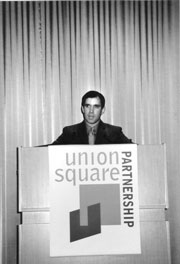By Sascha Brodsky
City Council Speaker Gifford Miller is calling for the federal government to release $3 billion in disaster aid.
Miller told a Union Sq. Partnership Forum breakfast at the Con Ed Building on Irving Pl. last Tuesday that the amount is what the General Accounting Office says the city lost in local revenues because of 9/11. The 34-year-old speaker is considered a likely candidate in the 2005 mayoral race.
“Congress should remove the recently imposed cap on the community-disaster loan program,” Miller said. “The federal government used to offer that program to cities struck by disaster. Many cities and counties received this aid after hurricanes or floods. Why shouldn’t New York receive this assistance after having been attacked by al Qaeda?”
Miller used the forum for a wide-ranging speech on the city’s economic problems. He hailed the success of the 14th St. Business Improvement District — recently renamed the Union Sq. Partnership — and said it would provide a model for other areas of the city. The Council has increased funding for 20 BIDs throughout the city, Miller added.
“Since the Council took office in January 2002, we have extended one BID and created two new ones in downtown Flushing and on Sutphin Boulevard in Jamaica, Queens,” he said. “We increased city funding for 20 BIDs throughout the city, including many that had not received a boost since their inception.”
The public school system needs a vast infusion of cash, Miller said. Just to complete unfinished projects, more than $3.5 billion is needed, he added. A recent Council report estimates that the schools need to spend about $12.8 billion over the next five years to upgrade facilities and decrease overcrowding. Despite the city’s financial problems, great strides have been made in improving the school system, Miller said.
“In 1990, a child beginning kindergarten in a New York City public school entered a system whose physical facilities were described at the time by the New York State Legislature as ‘deplorable,’ ” he said. “That year, 50 percent of all elementary schools were overcrowded and almost 35,000 work orders for facilities repairs were backlogged. And when this same child entered eighth grade in 1998, over 54 percent of elementary and middle schools were overcrowded and there had been little improvement in school maintenance. In 2001, this child entered 11th grade when almost 64 percent of city high schools were overcrowded. The child — now a young adult — graduated last June without ever attending a school with adequate space, that had an art room or a music room or a science lab, or that was in a state of good repair.”
To prevent future problems with schools, Miller said that the new capital facilities plan must create additional capacity to relieve overcrowding, return “all public schools to a state of good repair” and “ensure that all school buildings have science and computer labs, facilities for arts and athletics, teacher work space, pre-kindergarten classes and adequate building security.”
The Council has also made progress in balancing the budget, Miller said.
“The Council has worked with the mayor to adopt nearly $2.7 billion in spending cuts,” he said. “We continue to fight for another $500 million in additional savings we believe are justified. Last year, the mayor proposed a 25 percent increase in property taxes. The Council negotiated that proposed increase down to 18 and a half percent.
“We wanted to lower the rate even more,” Miller continued. “Because we understand it represents a financial strain for many working and retired New Yorkers. But given the dire economic conditions and the impact of 9/11, we simply had no choice. The city must have the revenue to sustain essential services. We will not go back to the ’70s.”
Miller said that urban areas are at an economic disadvantage for government subsidies. Farming states receive agricultural support from the federal government but programs targeting the urban poor require states to provide matching funds, he said.
“The federal government’s inconsistent and unfair funding formulas suck billions of dollars out of New York City year after year after year,” he said. “New York city spends nearly $4 billion of our taxpayers’ money in matching funds for Medicaid. That’s almost the same amount as our entire personal income tax receipts. Why must states match federal funds for TANF — Temporary Assistance for Needy Families — but not for permanent assistance for needy farmers?”







































